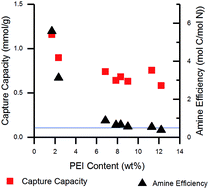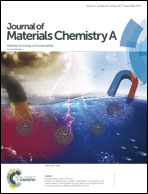Pore structure–CO2 adsorption property relations of supported amine materials with multi-pore networks
Abstract
Conventional supported amine adsorbents to date are known to suffer from the trade-off between increasing amine content and decreasing access to amine sites. In this work, we propose a solution to this known issue by introducing substrates with multiple pore networks where each pore channel can be used for amine loading and gas diffusion. It was hypothesized that these types of substrates with a multi-pore system would allow for a high amine content without a decrease in diffusion speed or amine efficiency. As a proof of concept, a 3-dimensional silica mesoporous framework composed of agglomerated spheres of microporous zeolite beta was loaded with large or small amine-containing molecules. The resulting hybrid adsorbents include mesopores loaded with large amine molecules or micropores incorporating small amine molecules, where molecular recognition using different pore dimensions allows selective incorporation of amine groups according to their molecular size. As a result of this selective amine loading, the supported amine adsorbent system proposed here demonstrates fast sorption kinetics at all amine loadings while maintaining amine efficiencies near the theoretical maximum value, which has not been achieved in supported amine adsorbents of this class as yet. Thus, this work may unlock new opportunities for the study of solid amine adsorbents with high efficiency amine utilization and fast achievement of near equilibrium capacities.



 Please wait while we load your content...
Please wait while we load your content...